| |
| 1) A rhombus is a quadrilateral with four congruent sides. |
|
|
|
| |
|
| Activity: Follow the steps in the unit link to "Rhombi and Squares" and construct rhombus TUVW. |
|
|
| |
| 2) When constructing the rhombus in the previous activity, how were you able to create the four congruent sides? |
|
4000 character(s) left
Your answer is too long. |
|
|
Attachments |
|
| 3) Theorem 15-A: The diagonals of a rhombus bisect its four angles. |
|
|
|
| |
|
| 4) In the unit link to “Rhombi and Squares”, refer to the proof of Theorem 15-A. The first half of the proof is completed by showing that diagonal PR bisects angles SPQ and SRQ. How would you prove that angles 3 & 4 are congruent and angles 7 & 8 are congruent? |
|
4000 character(s) left
Your answer is too long. |
|
|
Attachments |
|
| 5) Theorem 15-B: The diagonals of a rhombus are perpendicular. |
|
|
|
| |
|
| 6) How can you apply Theorem 15-A and the definition of a rhombus to the figure below to prove that the diagonals of a rhombus are perpendicular to each other? (Theorem 15-B) (Hint: You will need to recall the definition of a linear pair.) |
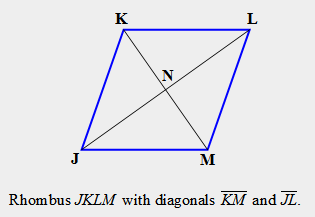 |
20000 character(s) left
Your answer is too long. |
|
|
Attachments |
|
| Refer to rhombus JKLM to answer the next three questions. |
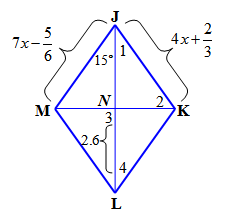 |
|
| |
| 7) Answer the following questions: (a) What is the measure of angle 1? (b) What is the measure of angle 2? (c) What is the measure of angle 3? (d) What is the measure of angle 4? |
|
4000 character(s) left
Your answer is too long. |
|
| |
|
| 8) What is the value of “x”? |
|
|
|
| |
|
| |
|
| |
|
| |
|
| 12) A square is a quadrilateral with four right sides and four congruent angles. |
|
|
|
| |
|
| Activity: Use a compass to construct a square. Follow the steps for constructing a rectangle, but adapt the method so that the rectangle is a square. |
|
|
| |
| 13) In the previous construction, how did you adapt the method for constructing a rectangle to construct a square? |
|
4000 character(s) left
Your answer is too long. |
|
|
Attachments |
|
| Refer to the Venn diagram in the unit link to "Rhombi and Squares" to determine if the statements are true or false in the next five problems. |
|
|
| |
| 14) Every rectangle is a parallelogram. |
|
|
|
| |
|
| 15) Every square is a rectangle. |
|
|
|
| |
|
| 16) Every rhombus is a square. |
|
|
|
| |
|
| 17) All squares are rectangles and rhombi. |
|
|
|
| |
|
| 18) All quadrilaterals are parallelograms. |
|
|
|
| |
|
| Copy or print out the table below and fill in the cells with “yes” if the property is true about the figure or “no” if the property is not true about the figure. Use your completed table to solve the next four problems and select the phrase that best completes the sentence. Make sure that you read each choice before making the selection. |
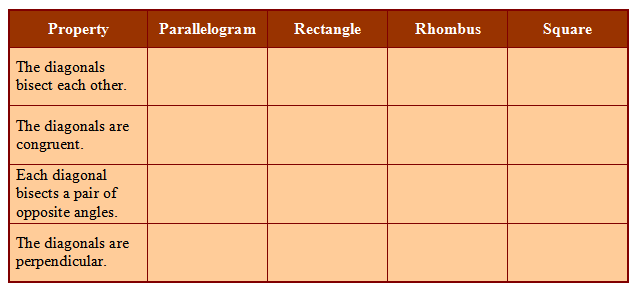 |
|
| |
| 19) The diagonals are perpendicular in _____. |
|
|
|
| |
|
| 20) The diagonals are congruent in _____. |
|
|
|
| |
|
| 21) The diagonals bisect each other in _____. |
|
|
|
| |
|
| 22) Each diagonal bisects a pair of opposite angles in _____. |
|
|
|
| |
|
| 23) Sketch Parallelogram EFGH with vertices E(1, 2), F(3, 8), G(5, 2), and H(3, –4) on graph paper, and then answer the following questions: (a) What is the length of each side of the parallelogram? (b) What is the length of each diagonal? |
|
4000 character(s) left
Your answer is too long. |
|
| |
|
| 24) Which of the following is true about parallelogram EFGH in the previous problem? |
|
|
|
| |
|
| |
| 25) A trapezoid is a quadrilateral with exactly two pairs of parallel sides. |
|
|
|
| |
|
| 26) Answer the following questions about trapezoid DEFG shown below. (a) Name the two bases. (b) Name the two legs. |
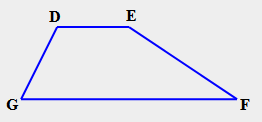 |
4000 character(s) left
Your answer is too long. |
|
| |
|
| Select “True or False” in the next three problems. |
|
|
| |
| 27) The quadrilateral is a trapezoid. |
 |
|
|
| |
|
| 28) The quadrilateral is a trapezoid. |
 |
|
|
| |
|
| 29) The quadrilateral is a trapezoid. |
 |
|
|
| |
|
| 30) An isosceles trapezoid is a trapezoid with congruent legs. |
|
|
|
| |
|
| 31) Sketch trapezoid HJKL with vertices H(–4, 2), J(1, 7), K(8, 4), and L(–1, –5) on graph paper, and then answer the following questions: (a) Name the parallel sides. (b) What are the slopes of the parallel sides? (c) What are the lengths of the non-parallel sides? (d) Is the trapezoid an isosceles trapezoid? |
|
4000 character(s) left
Your answer is too long. |
|
| |
|
| 32) Theorem 15-D: In an isosceles trapezoid, both pairs of base angles are congruent. |
|
|
|
| |
|
| 33) . Theorem 15-E: In an isosceles trapezoid, the diagonals are not congruent.. |
|
|
|
| |
|
| 34) Fill in the blank. The median of a trapezoid is a segment that joins the congruent of its legs. |
|
|
|
| |
|
| Activity: Print out or copy trapezoid TRAP and use a compass and straightedge to construct its median. Refer to the unit link to “Trapezoids” for the steps to construct the median of a trapezoid. |
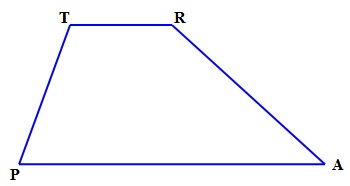 |
|
| |
| |
|
| |
|
| |
|
| Refer to isosceles trapezoid PQRS with median MN and diagonals PR and QS as shown below to answer the next four questions. |
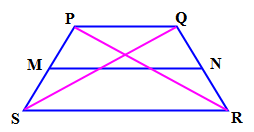 |
|
| |
| |
|
| |
|
| |
|
| 41) If angle SPQ measures 12x + 73 and angle PQR measures 15x + 61, answer the following questions: (a) What is the value of “x”? (b) What is the value of angle SPQ? (c) What is the value of angle PQR? |
|
4000 character(s) left
Your answer is too long. |
|
| |
|
| |
|
| |
| 43) A kite is a quadrilateral with exactly two distinct pairs of adjacent congruent sides. |
|
|
|
| |
|
| 44) Theorem 15-G: The diagonals of a kite are perpendicular. |
|
|
|
| |
|
| Refer to the diagram of kite GHJK to answer the next four questions. |
 |
|
| |
| 45) True or False? Triangle HJK is an isosceles triangle. |
|
|
|
| |
|
| 46) True or False? Triangle HGK is an equilateral triangle. |
|
|
|
| |
|
| 47) True or False? Diagonal HK is perpendicular to diagonal GJ. |
|
|
|
| |
|
| 48) True or False? Diagonal GJ is congruent to diagonal HK. |
|
|
|
| |
|
| 49) Study the chart shown below. Where does “kite” belong on this chart? |
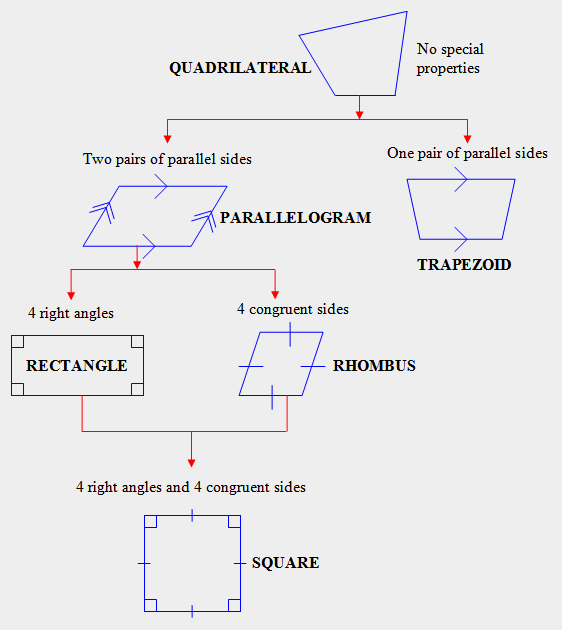 |
4000 character(s) left
Your answer is too long. |
|
|
Attachments |
|
| 50) Refer to the scenario below, and then explain how proving the congruency of triangles XWZ and YZW would help to prove that triangle XPY is an isosceles triangle. |
 |
20000 character(s) left
Your answer is too long. |
|
|
Attachments |
|
| Extended Research: Check with your instructor to see if he/she is interested in awarding extra credit to you for writing a one-page report on the following research topic: How were trapezoids used in ancient history architecture? Some topics to explore are the construction of the Mayan Pyramids and China’s Great Wall. You may include pictures that you find. Be sure to report all websites or other resources that you referenced to compile your report. |
|
|
| |
| 51) If you were directed by your school to complete Offline Activities for this course, please enter the information on the Log Entry form. |
|
| No offline activities found |
| 0 Hour(s) & 0 Minute(s) |
|
|
Attachments |
|